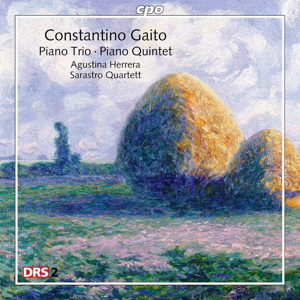
Constantino Gaito (1878-1945)
Piano Trio, Op. 25 (1917)
Cello Sonata, Op. 26 (1918)
Piano Quintet, Op. 24 (1917)
Agustina Herrera (piano), Sarastro Quartett
rec. 2009, Zurich, Switzerland
cpo 777 514-2 [56]
This CD – made by cpo in association with Schweizer Radio DRS 2 – speaks volumes for the mission that seized hold of Agustina Herrera to revive the music of her great-grandfather, Constantino Gaito. She wanted to do this “with the utmost respect, earnestness and commitment”. The results reflect the achievement of that goal. It’s compelling stuff and has nothing about it that smacks of special pleading outstripping talent, hagiography or chipped plaster saints. Family initiatives rooted in years of respect can produce stultifying results; not so in this case. Hearing this music in these performances, which brim with arterial commitment, is the more to be prized. The surprise of discovery is matched by the music’s intrinsic radiance.
Argentinean composer Constantino Gaito owed the honing of his talents to his musical education at the Naples Conservatory. He also assisted in the Argentinean premiere of Verdi’s Falstaff. His own numerous operas include at least one – Ollantay (1925) – that has been recorded commercially. Not to be left out of the reckoning are two potentially telling tone poems: El Ombú (1924) and Vision (1928), which was conducted by Klemperer in Buenos Aires. Let’s hear them, please. His two string quartets have been recorded commercially by the Sarasto Quartett, who play on this present disc.
Almost all of Gaito’s chamber music dates from the years 1917-18. The String Quartet No. 2 is an exception; it hails from 1925. The present trio of three-movement works, hovering either side of the twenty-minute mark, are fluent expressions of a high romantic impulse that cannot be stemmed. They feel fresh – the melodies are of good quality – yet leave you in little doubt about their indebtedness to Korngold, Dvořák, Rachmaninov, Fauré and Schmidt. All three are well balanced; Gaito clearly had a gift for matching his often torrential ideas with the ideal scale of canvas across which to express them. I never felt my attention over-strained by what I heard. All three works were premiered in Argentina with Gaito as pianist. The performances reek of spur-of-the-moment identification and of musicians engaging at close quarters with the composer’s creative vision. The Trio declares its hand with rhythm and character and it somehow comes as no surprise to read that it was written within a fortnight. The Cello Sonata is just as good. It squares up confidently to one of my litmus tests: the John Foulds Cello Sonata (1905), especially in its sensational broadcast by Moray Welsh and the composer-pianist Ronald Stevenson. The Quintet stirs memories of Fauré. There’s a whirlwind of the emotions in the outer-facing movements. The central Andante breathes the most tender of emotions.
The notes in the chunky 24-page booklet are in German, English and Spanish.
Rob Barnett
Help us financially by purchasing from




















